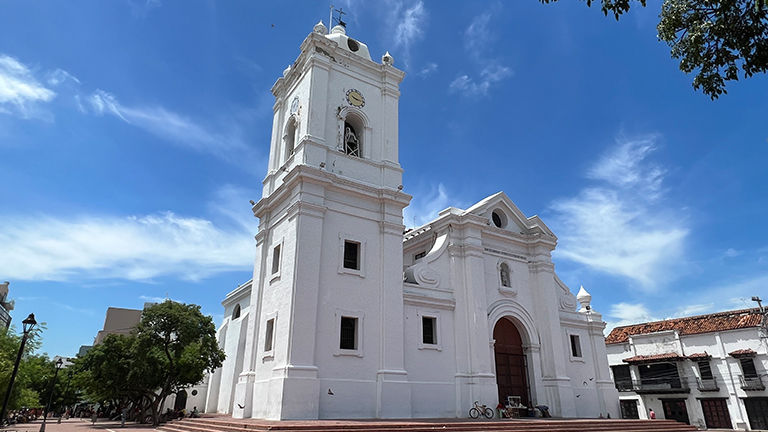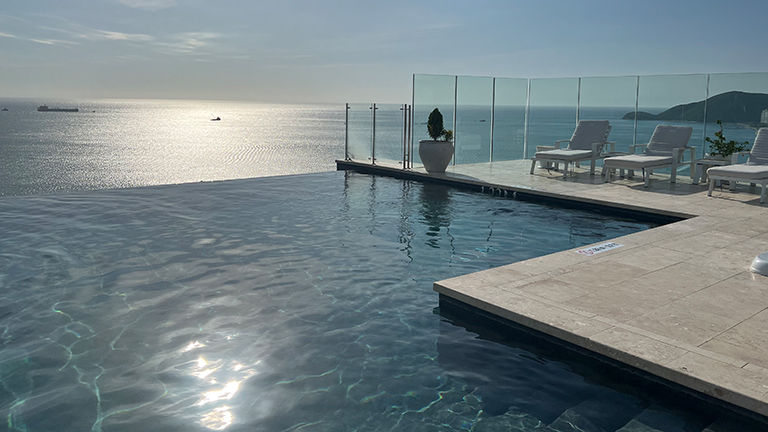Anyone who’s visited the Caribbean is familiar with the beauty of its beaches. But I had never visited anywhere in the region quite as expansive and unspoiled as Tayrona National Natural Park, a protected area on Colombia’s Caribbean coast near the city of Santa Marta. With more than 58 square miles of lush vegetation and unspoiled beaches, Tayrona is just one visually stunning reason why Santa Marta is landing on the radar of more travelers.
With a population of around 500,000, the city of Santa Marta is far from the largest city in Colombia. But its importance as a tourism destination isn’t built on size, but rather on its ability to serve as a multifaceted gateway to nature, history and culture.
Tayrona is likely the best-known reason for travelers to visit Santa Marta. But it’s far from the only attraction, as I found out during a recent trip hosted by MagicTour Colombia, a local tour operator that offers an array of services and also partners with Out in Colombia, an LGBTQ+ tour company that operates in multiple Colombian destinations.
History and Culture in Santa Marta
As the oldest colonial city in Colombia (founded in 1525), Santa Marta is an ideal destination for history fans. During a walking and driving tour, we explored fascinating historic sites, including the Museo del Oro Tairona (Tairona Gold Museum), which is housed in a historic former customs house that dates to 1730 and exhibits pre-Columbian gold and pottery, as well as hundreds of other artifacts. Just a few blocks away, we admired the Cathedral of Santa Marta, which was originally founded in 1531, although its current structure dates to the 18th century.
 The Cathedral of Santa Marta
The Cathedral of Santa Marta
Credit: 2023 DepartureLevel.comA few minutes away by car is La Quinta de San Pedro Alejandrino, the place where Simon Bolivar — the celebrated liberator of this region of South America — spent his final days. This historical landmark is now a museum and cultural center.
I also enjoyed learning about the region’s gustatory traditions. We headed up into the verdant foothills of the Sierra Nevada mountains to Minca, an atmospheric town where coffee farm tours are a popular activity. As a non-coffee-drinker with a strong sweet tooth, I was thrilled that we opted instead to visit a cacao farm to learn about local chocolate production techniques. (Those who’d like to spend more time enjoying Minca’s relaxed ambiance can overnight at small hotels like On the Rock, where we enjoyed a tasty rooftop lunch.)
Santa Marta is also a gateway for learning about diverse cultures. Four Indigenous communities — the Koguis, Arahuacos, Wiwas and Kankuamos — call this area home. Among the most fascinating (and physically demanding) ways to learn about local Indigenous history is to visit the Ciudad Perdida (Lost City), the ruins of a civilization in the northern Sierra Nevada that date to sometime between AD 500 and 700. MagicTour offers a guided three- or four-day trek, but participants need to be in good physical shape for the extensive hiking required.
Cuisine is another especially rewarding way to immerse oneself in local traditions. Santa Marta’s local specialties include coconut fish, fried fish and arepas (deep-friend corn cakes). I especially enjoyed meals at Pescao, which opened in January 2023 and is decorated with local artwork, and Guasimo, a stylish venue that often hosts live music.
 A dance performance at Pescao
A dance performance at Pescao
Credit: 2023 DepartureLevel.comExploring Nature in Santa Marta
There are lots of reasons why Santa Marta is popular with nature-lovers. The region is home to multiple national natural parks — the most celebrated of which is Tayrona.
My cellphone camera got quite a workout when our tour group visited this legendary stretch of Caribbean coastline. We took a 45-minute boat ride from a city marina to arrive at this paradise, which is graced with pristine beaches and multiple places for swimming, boating and hiking, with not a single big building in sight (and no hotels).
Bird-lovers will also do well in Santa Marta. The area is home to 202 species of birds, which represents 35% of Colombia’s birds and 7% of the world’s bird population, according to official tourism figures. Among the best places to view them is El Dorado, a nature reserve in the Sierra Nevada mountains where visitors can view species including the Santa Marta parakeet during guided birdwatching tours.
Getting to Santa Marta, and Where to Stay
The most frequent air service to Santa Marta is from Bogota on multiple airlines; the flight is just over an hour. Travelers from the United States can also reach Santa Marta by connecting with flights from Miami on Avianca and Panama City on Copa Airlines. The city is also about two hours by car from Barranquilla, although travel time can vary based on traffic.
 Hilton Santa Marta features a rooftop infinity pool.
Hilton Santa Marta features a rooftop infinity pool.
Credit: 2023 DepartureLevel.comThere are several internationally branded hotels in Santa Marta. The newest is the 261-room Hilton Santa Marta, which opened this year in the upscale beachfront neighborhood of Bello Horizonte. It also happens to be where I stayed, and I enjoyed my spacious junior suite and the spectacular Caribbean views from my balcony, as well as the rooftop infinity pool. It was yet another example of how easy it is in Santa Marta to find photo-worthy views.